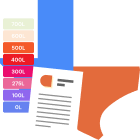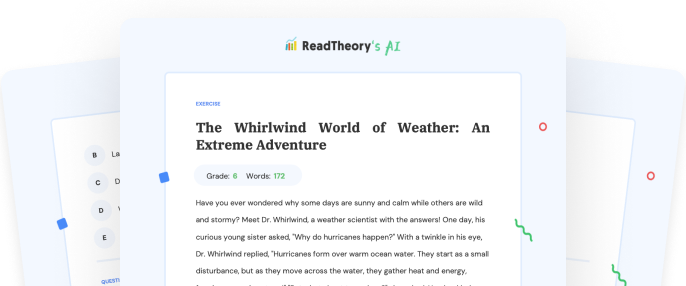Transform Your Teaching
with AI-Powered Worksheets
With ReadTheory’s Instant Worksheet Builder, you can create engaging, grade-appropriate worksheets tailored to your students in minutes. Spark curiosity, save time, and empower critical thinking with AI-powered tools designed for teachers like you.


Our Cosmic Neighborhood: The Solar System
Our Solar system, a cosmic neighborhood bustling with celestial bodies, is an awe-inspiring part of the Milky Way galaxy. At the heart of this system is the sun, a massive star radiating light and heat that powers life on Earth. Orbiting the sun are eight diverse planets, each with its unique characteristics. Mercury, closest to the sun, endures scorching temperatures, while Neptune, the farthest, is icy cold. Venus, our neighboring planet, is the hottest due to a runaway greenhouse effect. Ever wondered about the red color of Mars? Iron oxide, or rust, gives the Martian soil its distinctive hue. Jupiter, the giant of our solar system, has a colossal storm, the Great Red Spot, that has raged for hundreds of years. Saturn stands out with its spectacular ring system made of ice and rock. Between Mars and Jupiter lies the asteroid belt, home to rocky remnants from the solar system's formation. Farther out, the Kuiper Belt hosts icy objects including Pluto, once considered the ninth planet. Our solar system is vast, with enormous distances separating these celestial bodies. Yet, it's just a tiny speck in the grand scale of the universe, which contains billions of other galaxies. As we continue to explore this cosmic frontier, who knows what astonishing discoveries await us?
Question 1
What gives Mars its distinctive red color?
Red Sand
Iron Oxide
Copper Oxide
Red Soil
Volcanic Lava
Question 2
What is the name of the colossal storm on Jupiter?
Big Red Spot
Giant Cyclone
Jupiter's Fury
Great Red Spot
Hurricane Jupiter
Question 3
What is the composition of Saturn's ring system?
Gas and Dust
Metal and Rock
Ice and Rock
Ice and Gas
Dust and Rock
Question 4
Which planet was once considered the ninth planet of our solar system?
Jupiter
Neptune
Uranus
Pluto
Mars
Question 5
Why is Venus the hottest planet in our solar system?
Because it's closest to the sun
Because of its volcanic activity
Because it has a thick atmosphere
Because of a runaway greenhouse effect
Because it's the second largest planet
 or share via
or share via

Assign the ReadTheory pretest to determine students' reading levels.

Why Teachers Love
Instant Worksheet Builder?

Tailored Content for Every Student
Craft worksheets with passages and multiple-choice questions customized to your chosen topic and grade level, ensuring relevance and engagement.

Save Hours
of Prep Time
Our AI, Lexi, generates complete worksheets—passages, questions, and answers—in minutes, freeing you to focus on teaching, not planning.

Standards-Aligned Learning
Every worksheet is designed to boost reading comprehension and critical thinking, aligning seamlessly with State Standards to help your students shine.
Personalized teaching
for personalized learning
Browse worksheets created and refined by educators using Lexi—your source for inspiration and ready-to-use resources.


ReadTheory is free for Teachers to use.
Join thousands of educators using ReadTheory for free. Sign up today and start creating in just minutes!





